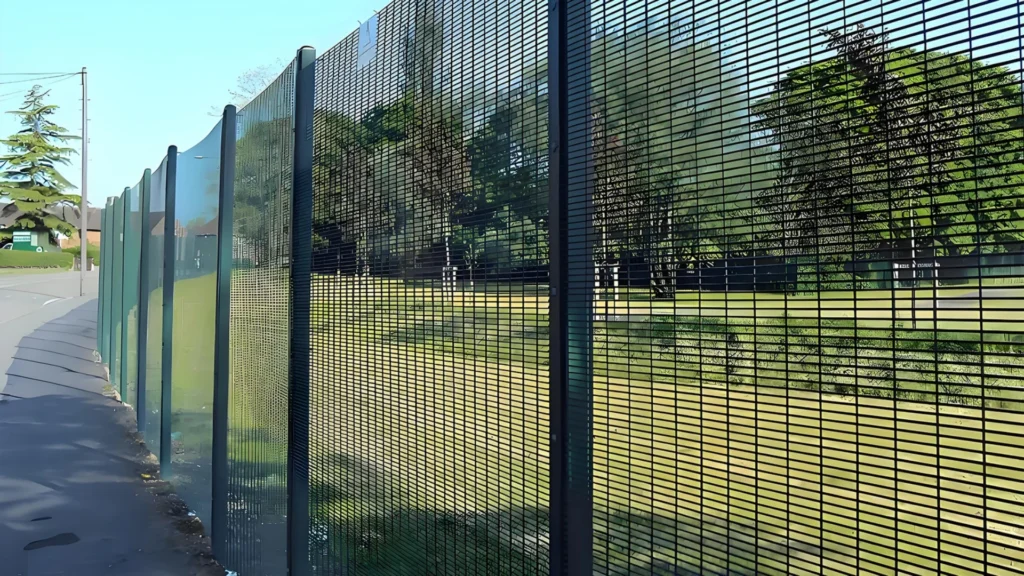(BS Standards Explained, with 2D/3D Wire Mesh, Chain Link & More)
When people come to securing property here in England, metal fences are the go-to choice. Whether you’re after something neat for the garden, heavy-duty for a warehouse, or proper industrial security, there’s a British Standard to keep it all above board. Let’s walk through the most common types: metal fence posts, metal gates, 2D & 3D wire mesh fences, and the classic chain link fence.
1. Metal Fence Posts – Built to Last
A good fence is only as strong as its posts. In the UK, posts are generally made from galvanised steel, and if you want to meet the regs, you’ll often see BS EN 10244-2 for galvanizing and BS EN 10305 for structural performance.
Typical features:
- Square or round hollow sections
- Powder-coated (usually RAL 6005 green or RAL 7016 anthracite)
- Heights from 1.8m to 3m, depending on security needs
Illustration idea: A cross-section showing the post embedded 600mm in concrete, with BS reference stamped on the steel.
2. Metal Fence Gates – Matching the System
Meatal Gates should blend with the fence style but must be sturdier, especially for driveways or industrial sites. Look for:
- BS EN 13241 (for industrial and commercial gates)
- BS EN 12453 (if it’s automated)
You can get single-leaf pedestrian gates or double-leaf vehicle gates, usually with welded mesh or chain link infills to match the fence line.
Illustration idea: Side-by-side images of a pedestrian gate (1m wide) and a double-leaf swing gate (4m wide), both with matching mesh panels.
| Fencing Component | Illustration Idea | Key British Standards to Show |
|---|
| Metal Fence Post | Cross-section of a steel post embedded 600mm into a concrete foundation, with dimensions labelled (post size, embed depth). Add a “BS EN 10305 / BS EN ISO 1461” stamp etched on the post. | BS EN 10305 (steel tubes), BS EN ISO 1461 (hot-dip galvanizing) |
| Metal Fence Gate | Side-by-side drawings of a single pedestrian gate and a double-leaf vehicle gate, each with welded mesh infill panels matching the surrounding fence. Show hinge and lock details. | BS EN 13241 (industrial gates), BS EN 12453 (powered gates if automated) |
| 2D Mesh Panel | Flat double-wire mesh panel with callouts for 6/5/6mm wire diameter, 50x200mm mesh aperture, and powder-coated finish. | BS EN 10223-7 (welded mesh panels), BS EN 10244-2 (wire coating) |
| 3D Mesh Panel | Same as 2D but with “V” profile bends shown in perspective, highlighting increased rigidity with fewer horizontal wires. | BS EN 10223-7, BS EN 10244-2 |
| Chain Link Fence | Roll of chain link stretched between angle-iron posts with straining wire, showing mesh aperture (50mm) and wire gauge (3.15mm). | BS EN 10223-6 (chain link), BS EN ISO 1461 (galvanized posts) |
3. 2D & 3D Wire Mesh Fencing
These are the “modern” looking fences you see around schools, car parks, and industrial estates.
Industrial Fencing Comparison: 2D Mesh vs 3D Mesh vs Chain Link (UK Standards)
| Feature | 2D Mesh Fence (Double Wire) | 3D Mesh Fence (Profiled Panels) | Chain Link Fence |
|---|---|---|---|
| Best for | Warehouses, airports, high-security sites | Schools, car parks, commercial estates | Temporary sites, sports grounds, perimeters |
| Wire Diameter | 6/5/6mm or 8/6/8mm (extra rigid) | 4/5mm to 5/5mm (lighter, with “V” bends) | 2.5–4mm (woven) |
| Panel Structure | Flat, double horizontal wires for strength | Welded mesh with pressed V-shaped profiles | Flexible woven mesh |
| Security Level | High – difficult to cut or climb | Medium – good visibility, moderate strength | Low to medium – depends on wire gauge |
| Durability | Hot-dip galvanised + powder coated (BS EN 10223-7) | Hot-dip galvanised + powder coated (BS EN 10223-7) | Galvanised or PVC coated (BS EN 10223-6) |
| Cost | Higher (premium industrial choice) | Moderate (cost-effective for mid-level security) | Lower (budget-friendly option) |
| Aesthetic | Sleek, professional finish | Modern look with profile bends | Traditional utilitarian style |
| Installation | Heavier, needs robust posts | Easier to handle and install | Quick to roll out over large areas |
2D Mesh (Double Wire)
- Flat panels with 6/5/6mm or 8/6/8mm wires
- No bends, super rigid
- Meets BS EN 10223-7 for welded mesh panels
3D Mesh (Profiled Panels)
- Same welded mesh but with “V” bends for extra strength
- Slightly lighter wires, more cost-effective
- Also falls under BS EN 10223-7
Illustration idea: One image comparing flat 2D panels vs “V” shaped 3D panels, with callouts for wire diameters and coatings (galvanised + powder coated).
4. Chain Link Fence – The Classic Choice
Chain link is still king for gardens, sports grounds, and some temporary sites. In the UK, you’ll want to check:
- BS EN 10223-6 for chain link mesh
- BS EN ISO 1461 for hot dip galvanizing
Standard sizes:
- Heights: 1.2m, 1.8m, 2.4m
- Mesh apertures: 50mm or 60mm
- Can be PVC coated for extra durability
Illustration idea: A chain link roll stretched between angle-iron posts, labelled with wire gauge and coating thickness.
Which One’s Right for You?
- Homes & gardens: Chain link or light 3D mesh
- Schools & car parks: 2D mesh for extra rigidity
- Warehouses & airports: 3m-high double wire + matching gates
- High-security: Add barbed wire or razor coils (also covered by BS standards)
Final Word (From Someone Who’s Been There)
Truth is, there’s no “one size fits all.” But if you stick to the British Standards, you’ll get something that not only looks tidy but also passes inspections and lasts for years in our lovely, wet English weather.




